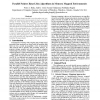Free Online Productivity Tools
i2Speak
i2Symbol
i2OCR
iTex2Img
iWeb2Print
iWeb2Shot
i2Type
iPdf2Split
iPdf2Merge
i2Bopomofo
i2Arabic
i2Style
i2Image
i2PDF
iLatex2Rtf
Sci2ools
ICDE
1996
IEEE
1996
IEEE
Parallel Pointer-Based Join Algorithms in Memory-mapped Environments
Three pointer-based parallel join algorithms are presented and analyzed for environments in which secondary storage is made transparent to the programmer through memory mapping. Buhr, Goel, and Wai [11] have shown that data structures such as B-Trees, R-Trees and graph data structures can be implemented as efficiently and effectively in this environment as in a traditional environment using explicit I/O. Here we show how higher-order algorithms, in particular parallel join algorithms, behave in a memory mapped environment. A quantitative analytical model has been developed to conduct performance analysis of the parallel join algorithms. The model has been validated by experiments.
Database | ICDE 1996 | Parallel Join Algorithms | Particular Parallel Join | Pointer-based Parallel Join |
| Added | 01 Nov 2009 |
| Updated | 01 Nov 2009 |
| Type | Conference |
| Year | 1996 |
| Where | ICDE |
| Authors | Peter A. Buhr, Anil K. Goel, Naomi Nishimura, Prabhakar Ragde |
Comments (0)

